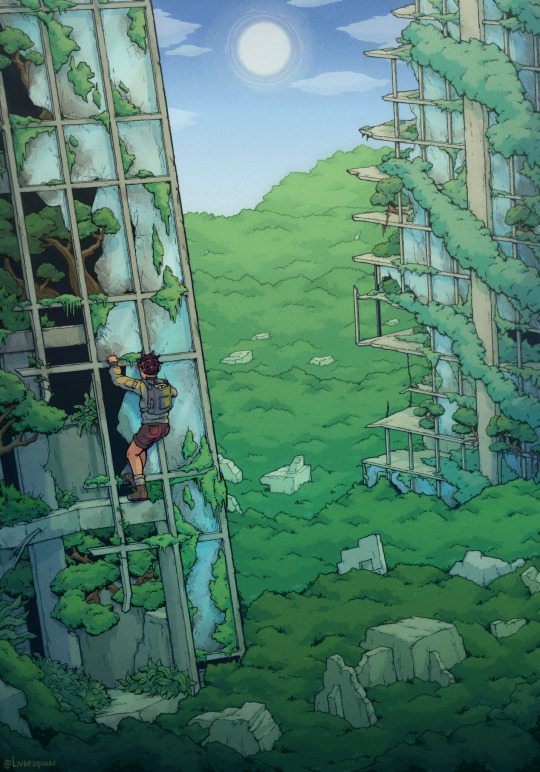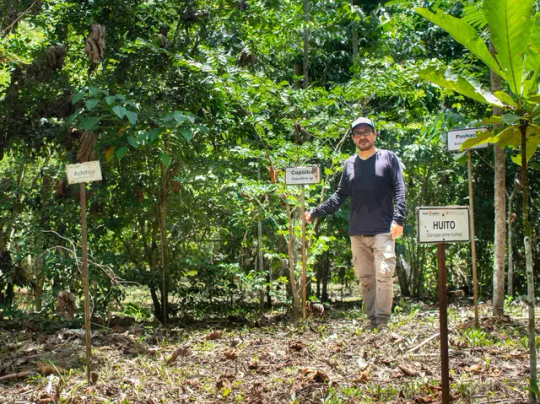Text
Tech bros who think digital is forever and that uploading your consciousness to a computer is immortality crack me up. Like bro, you'd be "immortal" on the computer for like a year until your own company sends out some software update that makes you incompatible and whoops, there goes TechBro.soul into the great Recycling Bin in the sky
23K notes
·
View notes
Text
Selected recurrent patterns or "laws" of evolution, of potential use for speculative biology. List compiled by Neocene's Pavel Volkov, who in turn credits its content to Nikolay Rejmers (original presumably in Russian). These are guidelines, and not necessarily scientifically rigorous.
Dollo's Law, or irreversibility of evolution: organisms do not evolve back into their own ancestors. When mammals returned to the sea, they did not develop gills and dermal scales and change back into fish: they became whales or seals or manatees, who retain mammalian traits and show marks of land-dwelling ancestry.
Roulliet's law, or increase of complexity: both organisms and ecosystems tend to become more complex over time, with subparts that are increasingly differentiated and integrated. This one is dodgier: there are many examples of simplification over time when it is selected for, for example in parasites. At least, over very large time scales, the maximum achievable complexity seems to increase.
Law of unlimited change: there is no point at which a species or system is complete and has finished evolving. Stasis only occurs when there is strong selective pressure in favor of it, and organism can always adapt to chaging conditions if they are not beyond the limits of survival.
Law of pre-adaptation or exaptation: new structures do not appear ex novo. When a new organ or behavior is developed, it is a modification or a re-purposing of something that already existed. Bone tissue probably evolved as reserves of energy before it was suitable to build an internal skeleton from, and feathers most likely evolved for thermal isolation and display before they were refined enough for flight.
Law of increasing variety: diversity at all levels tends to increase over time. While some forms originate from hybridization, most importantly the Eukaryotic cells, generally one ancestor species tends to leave many descendants, if it has any at all.
Law of Severtsov or of Eldredge-Gould or of punctuated equilibrium: while evolution is always slow from the human standpoint, there are moments of relatively rapid change and diversification when some especily fertile innovation appears (e.g. eyes and shells in the Cambrian), or new environments become inhabitable (e.g. continental surface in the Devonian), or disaster clears out space (e.g. at the end of the Permian or Cretaceous), followed by relative stability once all low-hanging fruit has been picked.
Law of environmental conformity: changes in the structure and functions of organisms follow the features or their environment, but the specifics of those changes depend on the structural and developmental constraints of the organisms. Squids and dolphins both have spindle-shaped bodies because physics make it necessary to move quickly through water, but water is broken by the anterior end of the skull in dolphins and by the posterior end of the mantle in squids. Superficial similarity is due to shared environment, deep structural similarity to shared ancestry.
Cope's and Marsh's laws: the most highly specialized members of a group (which often includes the physically largest) tend to go extinct first when conditions change. It is the generalist, least specialized members that usually survive and give rise to the next generations of specialists.
Deperet's law of increasing specialization: once a lineage has started to specialize for a particular niche, lifestyle, or resource, it will keep specializing in the same direction, as any deviation would be outcompeted by the rest. In contrast, their generalist ancestors can survive with a marginal presence in multiple niches.
Osborn's law, or adaptive radiation: as the previous takes place, different lines of descent from a common ancestor become increasingly different in form and specializations.
Shmalhausen's law, or increasing integration: over time, complex systems also tend to become increasingly integrated, with components (e.g. organs of an organism, or species in a symbiotic relationship) being increasingly indispensable to the whole, and increasingly tightly controlled.
185 notes
·
View notes
Text

Climbing remains of the old world
A concept art to my BA thesis film
450 notes
·
View notes
Text
One of the best and easiest job retraining programs is mine worker —> mine reclamation/restoration worker.
"Sunlight dapples the once-denuded forest floor as saplings spread their branches and leaves overhead, slowly forming a lush canopy.
Beside each young tree, a sign notes its species. Lupuna, says one, the colloquial Peruvian term, and below that its scientific name, Ceiba pentandra — in other words, a kapok tree, known for its cotton-like fibers. Huito, says another sign, or Geinpa americana, which produces edible gray berries.
Each sapling is distinct, a reflection of the Amazon's stunning biodiversity, with so many different species that you might go acres without finding a repeat.
Yet this young forest did not spring up naturally. It has been carefully recreated by humans in an area that was, until just three years ago, a heavily contaminated moonscape.
This land was stripped of its dense vegetation by miners scouring the subsoil for tiny specks of gold, using mercury to separate the gold from the sediment. Many thought that a healthy forest would never thrive in impoverished, mercury-laden topsoil and that the piles of sandy tailings, the residue from the gold mining effort, and the pools of wastewater were irremediable...
"It feels good to see the forest grow back," says Pedro Ynfantes, 66, the miner whose legal mining concession of 1,110 acres includes this 10-acre patch of land where this young forest is located. "We don't want to deforest. When we had the opportunity to let the forest grow back, we took it. It's much better this way."
The opportunity he refers to came via U.S. nonprofit Pure Earth, which works with communities across the Global Southto remediate environmental problems left behind by mining, much of it illegal. Their biggest targets are mercury and lead contamination...
Security forces have launched anti-mining operations down the years, even blowing up the miners' equipment deep in the jungle. But most local politicians, including Madre de Dios' members of Peru's national congress, broadly support the miners, who are a powerful constituency in the relatively sparsely populated jungle region.
Restoring the forest

Pictured: France Cabanillas works for the nonprofit group Pure Earth, which is spearheading an effort to plant saplings in areas of the Peruvian Amazon that were devastated by illegal gold mining.
Now there's an effort to address the damage. Initially working with the region's legal miners, most of whom were here before the 2009 gold rush kicked off, the nonprofit group Pure Earth is using this patch of Ynfantes' land as a pilot project to show how the rainforest can be regenerated after the last traces of gold have been plucked from the soil.
It took a sustained outreach effort. Many miners are wary of or even downright hostile to foreign NGOs, which have repeatedly called for gold mining to be banned or severely curbed in the Peruvian Amazon — steps they say would cost them their livelihood.
"I am feeling optimistic," says France Cabanillas, Pure Earth's local coordinator, who has been appealing to the frustration of many miners at the heavy toll they have taken on the jungle and their desire to minimize their environmental footprint for the next generation.
"We still have a lot to do but this pilot is going well. Down the years, the miners have been getting a lot of stick but not much carrot when it comes to their environmental impacts," says Cabanillas. "We are offering them a carrot, allowing them to remediate their own impacts. Many of the miners do not want to be destroying the rainforest."
Before the miners plant the carefully-selected mix of tree species, they had to prepare the earth. Most of the topsoil had been washed away by the miners' heavy use of hoses.
That preparation involved adding biochar (burnt organic material) and even molasses, which contain fixed carbon and minerals, along with various other nutrients. The miners also had to dig tiny moats around the saplings to prevent all of this new planting from being washed away. Now, after three years, the forest is visibly coming back.
The rejuvenated rainforest also mitigates the impact of the mercury used by many of the illegal miners.
Research done by Pure Earth shows that the barren, sandy soil emits mercury. But in a rainforest, the ecosystem actually absorbs some of the metal, boosting public health."
-via NPR, April 2, 2024
346 notes
·
View notes
Photo

The beekeepers of Mount Cyllene wear masks of spun honeycomb to filter the vapors of the nearby marsh, in Janet Aulisio’s cover for Craig Barrett’s “The Chest of the Aloeids” featuring the ancient Greek pantheon, Dungeon 21, TSR, Jan/Feb 1990
173 notes
·
View notes
Text
"what would it be like, I wondered, to live with that heightened sensitivity of the lives given for ours? To consider the tree in the Kleenex, the algae in the toothpaste, the oaks in the floor, the grapes in the wine; to follow back the thread of life in everything and pay it respect? Once you start, it's hard to stop, and you begin to feel yourself awash in gifts."
-Robin Wall Kimmerer, Braiding Sweetgrass
871 notes
·
View notes
Text

Why the fuck are we still obsessed with cars when we could be living in a world like this??
260 notes
·
View notes
Text
What could be more Appalachia futurist than a cyberpunk funicular?

Funicular by Anthony Brault - The steepest funicular in the cyber world
17 notes
·
View notes
Photo

@rj__46bex
5K notes
·
View notes
Link
It’s been said, most recently by John Rieder in “Colonialism and the Emergence of Science Fiction,” that the genre of science fiction, which often features the conquest of alien species and the settling of new worlds, is an emanation of 19th-century colonialism.
But Dillon, and Roanhorse herself, reject an obsession with colonialism. Dillon’s final theme is “Biskaabiiyang,” the Anishinaabe word she translates as “returning to ourselves.” Roanhorse says she refuses to be defined by the colonial experience and rather seeks to recover the Native place in the universe.
355 notes
·
View notes













